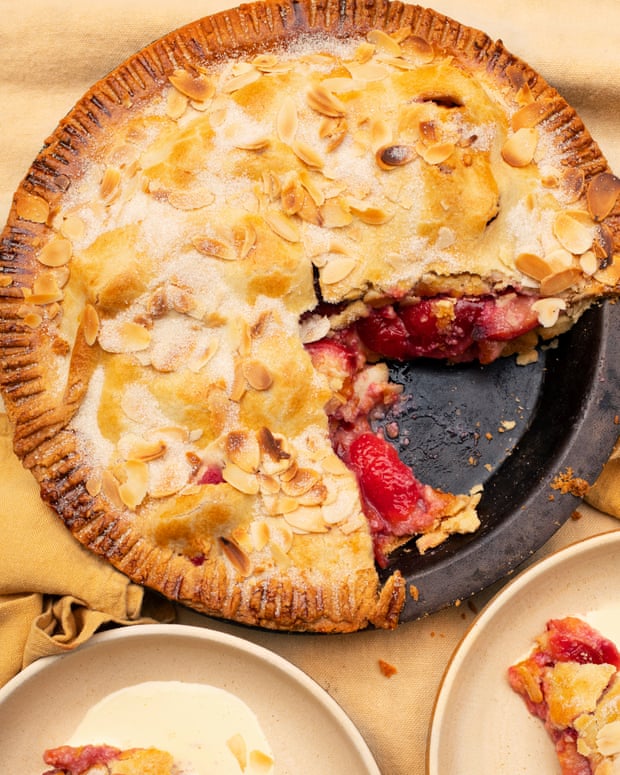
There was no sign of dessert. (I’m going back a bit now.) We looked anxiously at one another, wondering if our hosts had forgotten, or were about to bring out a plate of cheese. Suddenly our host stood up, slipped out into the garden and returned with a tree branch that he flopped, almost matter-of-factly on the dining table. Hidden among the leaves were plums, each one barely bigger than a blackbird’s egg, gold, freckled with rust and as sweet as honey. I cannot remember a more appealing pudding. I couldn’t bear to ask if the branch was a bit of unseasonal pruning or a spur of the moment thing. Whatever, it was a moment of genius.
The season for plums is short and precious, the out-of-season variety being almost inedible unless you cook them. The plum, like the fig, is a fruit on which to gorge. But unlike figs, they are relatively cheap, probably because the shops need to get them sold. Any that fail to ripen, as is occasionally the case, can be baked with a little honey or sugar, or brought to a sloppy jam on the hob, either with sugar or, as I did this week, pomegranate molasses, brown sugar and chilli flakes. A hot-sweet-tart accompaniment in which to dip a pork chop or a rib. (We also used it with thick slices of blue cheese, which was both dazzling and extraordinary.)
Plum pie is what you make when the plums are cheap. Jam when there is a glut, which you are only likely to experience if you have your own tree or a benevolent and generous neighbour. The juice that is so welcome in a plum crumble can be something of a nuisance in a pie – apt to make your bottom crust as soggy as a bath sponge. I get round this by tossing the stoned fruit with a mixture of jam and ground almonds before piling them on to the pastry. Cooking the pie on a hot baking sheet will help, too.
Grilled pork chops, chilli-plum jam
Right now, with the first plums appearing in the shops, I will either make a salad of them to accompany a plate of pork from the grill (a light sprinkling of red wine vinegar, walnut oil and a scattering of sesame seeds) or this mildly hot, somewhat addictive jam. Serves 4
pork steaks or chops 4 x 250g
groundnut or olive oil 1 tbsp
sage leaves 1 tsp, chopped
salt and black pepper
For the chilli plum jam:
plums 10, medium sized
garlic 1 clove, flattened with a heavy weight
soft brown sugar 35g
chilli flakes 1 tsp
pomegranate molasses 3 tbsp
lemon juice 1 tbsp
sherry vinegar 2 tbsp
Cut the plums in half and remove their stones. Cut each half in 2, then put in a nonstick saucepan with the clove of garlic, sugar, chilli and molasses and bring to the boil. Leave to simmer for 7-10 minutes, with the occasional stir, until the plums are soft enough to crush with a fork, then remove from the heat. Stir in the lemon juice and the vinegar, add a generous seasoning of salt then set aside. The jam will keep in a lidded container in the fridge for several days.
To cook the chops, first brush them with a little groundnut or olive oil. Using a pestle and mortar, grind together some salt and pepper, add the sage leaves, then season the pork. Heat a griddle pan, add the pork and press down firmly with a heavy weight. Leave to cook for 5-6 minutes, then turn, repeat and cook for a further few minutes until the pork fat is golden and the flesh inside is juicy and still be slightly pink inside. Serve with the plum sauce.
Plum and almond pie
A recipe that will also work with apricots and peaches. If your plums are unripe, then it is probably best to cook them a little before putting them into the pastry-lined tin. A few minutes in a shallow pan with a little sugar should help. Add the ground almonds once the fruit is soft.
For the pastry:
plain flour 250g
butter 125g
icing sugar 50g
milk 2-3 tbsp and a little extra
For the filling:
plums 1 kg
ground almonds 75g
plum jam 5 tbsp
lemon zest of 1
To finish:
egg 1, beaten
milk 1 tbsp
flaked almonds 2 tbsp
You will also need a shallow-sided tart tin measuring approximately 24cm in diameter.
Make the pastry: put the flour in a large bowl, cut the butter into dice and add to the flour, then rub the butter into the flour with your fingertips. Alternatively, use a food processor. Stir in the icing sugar and enough milk to bring to a smooth, rollable dough. Turn out on to a lightly floured board and knead briefly until you have ball. Cut into 2 halves, one slightly bigger than the other. Roll the larger of the 2 and fit it into the tart tin and its rim, pressing the pastry gently into the tin and patching any holes as necessary. Leave in the fridge to rest. Wrap the remaining pastry in parchment and chill in the fridge.
Halve and stone the plums. Cut each half into 4 slices, then toss with the almonds and jam. Finely grate the lemon zest and add to the plums.
Remove the pastry case from the fridge, then spoon in the plum and almond filling. On a lightly floured board, roll out the remaining pastry to a rectangle to fit the top of the pie. Brush the rim of the pastry case with a little milk and lower the lid into place, pressing the edges together to seal in the fruit. Rest the pie in the fridge for 20 minutes. Place an empty baking sheet in the oven to heat up (you will bake the tart on this.) Preheat the oven to 200C/gas mark 6. Brush the pastry lightly with the egg and milk and scatter with the flaked almonds, then bake for 40 minutes until golden brown.
I like to remove the pie from the oven after 30 minutes, sprinkle it with a little caster sugar and return it to the oven for 10 minutes or until golden. If it appears to be darkening more than you would like, lay a piece of foil loosely over the surface.
Follow Nigel on Twitter @NigelSlater



